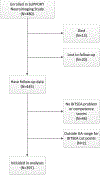Behavioral Deficits at 18-22 Months of Age Are Associated with Early Cerebellar Injury and Cognitive and Language Performance in Children Born Extremely Preterm
- PMID: 30292492
- PMCID: PMC6394414
- DOI: 10.1016/j.jpeds.2018.08.059
Behavioral Deficits at 18-22 Months of Age Are Associated with Early Cerebellar Injury and Cognitive and Language Performance in Children Born Extremely Preterm
Abstract
Objective: To investigate associations in toddlers born extremely preterm (<28 weeks) between neonatal neuroimaging and 18- to 22-month developmental and behavioral outcomes.
Study design: Cohort analysis from the Eunice Kennedy Shriver National Institute of Child Health and Human Development Neonatal Research Network Surfactant Positive Airway Pressure and Pulse Oximetry Trial Neuroimaging and Neurodevelopmental Outcomes Study of infants born extremely preterm. Subjects underwent cranial ultrasonography and near-term magnetic resonance imaging (MRI). At 18-22 months of corrected age, the assessment included the Brief Infant Toddler Social Emotional Assessment (BITSEA) Problem and Competence Scale scores and the Bayley Scales of Infant Development, Third Edition (Bayley-III). The BITSEA Problem Scale assesses dysregulation; the Competence Scale assesses social-emotional competence. We examined associations of Problem and Competence scores and positive screen rates with cranial ultrasonography and near-term MRI. Mean BITSEA and Bayley-III scores were compared using ANOVA and positive screen rates with the χ2 test. We computed correlations between BITSEA and Bayley-III scores.
Results: Of the 397 children, positive BITSEA screens were found in 34% for the Problem score and 26% for the Competence score. Presence of lesions on near-term MRI that included cerebellar lesions were significantly associated with lower BITSEA Competence but not with Problem scores; Competence scores were inversely related to the presence/significance of lesions. Positive screens on Competence scores and on both Competence and Problem scores were significantly associated with Bayley-III cognitive and language scores <85 (P < .001).
Conclusions: Social-emotional competence contributes to deficits in cognitive and language development. Presence of injury on near-term MRI that includes cerebellar lesions is associated with later social-emotional competence and may be a useful predictor to guide early assessment and intervention.
Trial registration: ClinicalTrials.gov: NCT00063063 and NCT00233324.
Keywords: behavior; extremely preterm; neuroimaging.
Copyright © 2018 Elsevier Inc. All rights reserved.
Figures


Comment in
-
Brain and behavior relationships in preterm children.J Pediatr. 2019 Jan;204:2. doi: 10.1016/j.jpeds.2018.11.013. J Pediatr. 2019. PMID: 30579464 No abstract available.

